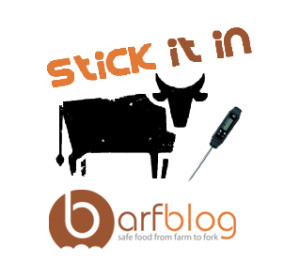Perhaps my Scottish food safety friend can comment. Thermometers would help.
 Richard Lloyd, executive director of Which? makes a strong case in The Scotsman for strong control of Campylobacter.
Richard Lloyd, executive director of Which? makes a strong case in The Scotsman for strong control of Campylobacter.
For the first time, the UK Food Standards Agency (FSA) named and shamed seven of the biggest supermarkets based on its testing results for Campylobacter. It wasn’t pretty reading, with the food safety watchdog detailing how more than 70 per cent of the fresh chickens it tested were contaminated with the potentially lethal bug.
Asda was found to have the highest levels, at 78 per cent, but none of the major retailers did well in this survey or met the FSA’s agreed joint industry target. The lowest rates were found in Tesco but it still had nearly two-thirds of samples contaminated (64 per cent). The results are a damning indictment of our big supermarkets, and consumers will be shocked at the failure of trusted household brands to stem the tide of increasingly high levels of Campylobacter. Supermarket bosses should hang their heads in shame.
The FSA’s retailer results were actually worse than a previous survey last August which didn’t name individual stores but showed around six in ten fresh chicken samples tested were contaminated with campylobacter. In research we undertook, as part of our new Make Chicken Safe campaign, we found six in ten people (61 per cent) expressed concern about these high levels, with three-quarters (77 per cent) saying they thought they were too high. More than half (55 per cent) thought that there wasn’t enough information available regarding Campylobacter levels in chicken.
By releasing information about which supermarkets are most affected, in the face of extreme pressure from industry to keep it anonymous, we hope the FSA will pile public pressure on the poor performers to improve and give consumers better information about campylobacter levels. We now want to see supermarkets not only publish effective plans to tackle these scandalously high levels but also demonstrate they’re taking real action to make chicken safe.
Although Campylobacter is the most common cause of food poisoning, cooking chicken at temperatures above 70ºC (165ºF) will kill the bacteria. And there are simple ways to minimize cross-contamination at home, for example not washing raw chicken, because the water can spray bacteria onto the surrounding area of your kitchen.
But we don’t think the onus should be on consumers to tackle this bug. Nearly nine in ten people (86 per cent) say they assume the food they buy from supermarkets won’t make them ill, and three-quarters of people (76 per cent) trust that the fresh chicken supermarkets stock is safe to eat. That is why Which?’s Make Chicken Safe campaign is calling for joint action from the supermarkets, regulator and the chicken processing industry to set out action to bring Campylobacter levels under control; and to publish the results of all the campylobacter testing they undertake.
 Controls need to be tightened at every stage of the supply chain, from farms to supermarkets. There can be no shirking responsibility – everyone involved in producing and selling chickens must act now and tell consumers what they’re doing to make sure the chicken we eat is safe. It’s now vital that the industry cleans up its act and works hard to restore consumer confidence.
Controls need to be tightened at every stage of the supply chain, from farms to supermarkets. There can be no shirking responsibility – everyone involved in producing and selling chickens must act now and tell consumers what they’re doing to make sure the chicken we eat is safe. It’s now vital that the industry cleans up its act and works hard to restore consumer confidence.
Reducing Campylobacter levels must also be firmly on the agenda for the new food safety body for Scotland, Food Standards Scotland (FSS), which will shortly be established as part of the Food (Scotland) Bill. Consumers need to be confident in the food they are buying and we want the FSS to put consumers at the heart of its work, right from the start.
To do this, FSS needs teeth and a team of experts led by a proactive chief executive who will be a true consumer champion – starting with tackling the campylobacter scandal.
